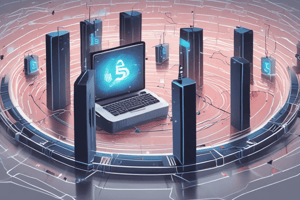Podcast
Questions and Answers
In a modern network security approach, what is the role of Network Admission Control (NAC)?
In a modern network security approach, what is the role of Network Admission Control (NAC)?
- To encrypt all data transmitted across the network.
- To provide advanced antimalware protection.
- To authenticate users and enforce network security policies. (correct)
- To filter URLs to prevent access to malicious websites.
What is a key difference between traditional endpoint security and modern endpoint security solutions?
What is a key difference between traditional endpoint security and modern endpoint security solutions?
- Traditional security relies on reactive measures, while modern security incorporates proactive threat intelligence and analysis. (correct)
- Traditional security uses hardware encryption, while modern security uses software encryption.
- Traditional security focuses solely on perimeter defense, while modern security includes endpoint protection.
- Traditional security is more effective against zero-day attacks than modern security.
Which of the following is a primary function of Cisco's Email Security Appliance (ESA)?
Which of the following is a primary function of Cisco's Email Security Appliance (ESA)?
- Managing and controlling network bandwidth allocation.
- Providing network intrusion detection.
- Blocking spam and providing advanced malware protection for email. (correct)
- Encrypting all web traffic.
What type of security threat is mitigated by implementing DHCP snooping?
What type of security threat is mitigated by implementing DHCP snooping?
What is the primary purpose of using port security on a network switch?
What is the primary purpose of using port security on a network switch?
How does a CAM table overflow attack compromise network security?
How does a CAM table overflow attack compromise network security?
What does Cisco's Advanced Malware Protection (AMP) provide in addition to traditional anti-virus software?
What does Cisco's Advanced Malware Protection (AMP) provide in addition to traditional anti-virus software?
Which Layer 2 attack involves manipulating the Spanning Tree Protocol (STP) to become the root bridge and intercept network traffic?
Which Layer 2 attack involves manipulating the Spanning Tree Protocol (STP) to become the root bridge and intercept network traffic?
What is the function of IP Source Guard in network security?
What is the function of IP Source Guard in network security?
What is VLAN hopping and what type of vulnerability does it exploit?
What is VLAN hopping and what type of vulnerability does it exploit?
How does a modern Web Security Appliance (WSA) protect a network from web-based threats?
How does a modern Web Security Appliance (WSA) protect a network from web-based threats?
Which of the following is a typical characteristic of a DHCP starvation attack?
Which of the following is a typical characteristic of a DHCP starvation attack?
What is the purpose of configuring 'switchport port-security mac-address sticky' on a switchport?
What is the purpose of configuring 'switchport port-security mac-address sticky' on a switchport?
When configuring port security, what is the 'violation mode' and what options are typically available?
When configuring port security, what is the 'violation mode' and what options are typically available?
How does implementing Dynamic ARP Inspection (DAI) contribute to network security?
How does implementing Dynamic ARP Inspection (DAI) contribute to network security?
What is the role of the Talos team in the context of Cisco's security solutions?
What is the role of the Talos team in the context of Cisco's security solutions?
In the context of network security, what does the term 'blacklisting' refer to?
In the context of network security, what does the term 'blacklisting' refer to?
What is the purpose of configuring a DHCP snooping limit rate on a switch interface?
What is the purpose of configuring a DHCP snooping limit rate on a switch interface?
When implementing port security, which aging type is most appropriate for environments where devices frequently move or change?
When implementing port security, which aging type is most appropriate for environments where devices frequently move or change?
Which of the following best describes the combined function of a Cisco Web Security Appliance (WSA) and Email Security Appliance (ESA) in a comprehensive security strategy?
Which of the following best describes the combined function of a Cisco Web Security Appliance (WSA) and Email Security Appliance (ESA) in a comprehensive security strategy?
What is a common method an attacker might use to initiate a CAM table overflow attack?
What is a common method an attacker might use to initiate a CAM table overflow attack?
How does implementing 802.1X authentication improve network security?
How does implementing 802.1X authentication improve network security?
What is the purpose of configuring VLAN trunk security, and what type of attack does it primarily mitigate?
What is the purpose of configuring VLAN trunk security, and what type of attack does it primarily mitigate?
What is one key benefit of using hardware-based encryption over software-based encryption for local data?
What is one key benefit of using hardware-based encryption over software-based encryption for local data?
What is the significance of the 'show mac address-table' command on a Cisco switch?
What is the significance of the 'show mac address-table' command on a Cisco switch?
Traditional endpoint security relies solely on network-based protections, neglecting host-based firewalls and intrusion prevention systems.
Traditional endpoint security relies solely on network-based protections, neglecting host-based firewalls and intrusion prevention systems.
In a borderless network, limiting security measures to antivirus software is sufficient to protect against the wide array of potential threats.
In a borderless network, limiting security measures to antivirus software is sufficient to protect against the wide array of potential threats.
Advanced Malware Protection (AMP) operates only after a malware attack by focusing solely on remediation.
Advanced Malware Protection (AMP) operates only after a malware attack by focusing solely on remediation.
Cisco AMP utilizes threat intelligence gathered from a broad range of sources, analyzing approximately 100 MB of security data daily.
Cisco AMP utilizes threat intelligence gathered from a broad range of sources, analyzing approximately 100 MB of security data daily.
A key feature of the Cisco Email Security Appliance is its ability to block spam, provide advanced malware protection, and control outbound messages.
A key feature of the Cisco Email Security Appliance is its ability to block spam, provide advanced malware protection, and control outbound messages.
When a client initiates a web request, the Cisco Web Security Appliance (WSA) intercepts the request, analyzes it for potential threats, and then forwards it to the internet.
When a client initiates a web request, the Cisco Web Security Appliance (WSA) intercepts the request, analyzes it for potential threats, and then forwards it to the internet.
Cisco NAC functions do not include policy enforcement; it only focuses on identifying users and devices on the network.
Cisco NAC functions do not include policy enforcement; it only focuses on identifying users and devices on the network.
Layer 2 vulnerabilities involve exploitation of the Physical and Application layers of the OSI model.
Layer 2 vulnerabilities involve exploitation of the Physical and Application layers of the OSI model.
In a CAM table overflow attack, the switch floods the network with traffic because it cannot determine the correct destination MAC address.
In a CAM table overflow attack, the switch floods the network with traffic because it cannot determine the correct destination MAC address.
The macof tool is used to mitigate CAM table attacks by preventing attackers from flooding the network with bogus MAC addresses.
The macof tool is used to mitigate CAM table attacks by preventing attackers from flooding the network with bogus MAC addresses.
Port security guarantees network performance by ensuring that only authorized devices can connect to a switch port.
Port security guarantees network performance by ensuring that only authorized devices can connect to a switch port.
Enabling sticky learning on a switch port allows the switch to dynamically learn and permanently store MAC addresses until manually deleted.
Enabling sticky learning on a switch port allows the switch to dynamically learn and permanently store MAC addresses until manually deleted.
In port security, the 'restrict' violation mode drops traffic from unauthorized MAC addresses, sends a syslog message, and increments the violation counter.
In port security, the 'restrict' violation mode drops traffic from unauthorized MAC addresses, sends a syslog message, and increments the violation counter.
A DHCP starvation attack renders a DHCP server unable to issue IP addresses by overwhelming it with requests, while a DHCP spoofing attack sets up a bogus DHCP server.
A DHCP starvation attack renders a DHCP server unable to issue IP addresses by overwhelming it with requests, while a DHCP spoofing attack sets up a bogus DHCP server.
Configuring DHCP snooping on a switch involves defining ports as either 'trusted' or 'untrusted', with 'trusted' ports being allowed to send DHCP responses.
Configuring DHCP snooping on a switch involves defining ports as either 'trusted' or 'untrusted', with 'trusted' ports being allowed to send DHCP responses.
In the context of endpoint security, 'blacklisting' refers to a technique that only permits known good URLs to be accessed, blocking all others.
In the context of endpoint security, 'blacklisting' refers to a technique that only permits known good URLs to be accessed, blocking all others.
ESA and WSA are legacy systems and offer similar functionaility to Antivirus software.
ESA and WSA are legacy systems and offer similar functionaility to Antivirus software.
Modern security solutions replaced the need for hardware and software encryption of local data.
Modern security solutions replaced the need for hardware and software encryption of local data.
In DHCP Snooping configurations, DHCP 'trust' is configured on the interfaces connecting to clients, not the DHCP server.
In DHCP Snooping configurations, DHCP 'trust' is configured on the interfaces connecting to clients, not the DHCP server.
Advanced Malware Protection (AMP) can block URLs.
Advanced Malware Protection (AMP) can block URLs.
Modern security solutions combine NAC, AMP, ESA and WSA functionality.
Modern security solutions combine NAC, AMP, ESA and WSA functionality.
1 TB of security intelligence data is analyzed daily using Cisco's threat defense.
1 TB of security intelligence data is analyzed daily using Cisco's threat defense.
The purpose of blacklisting is to ensure only trusted sources can access your server.
The purpose of blacklisting is to ensure only trusted sources can access your server.
Once sticky MAC Addreses are learned, they cannot be deleted.
Once sticky MAC Addreses are learned, they cannot be deleted.
Sticky learning requires a manual reboot to take effect.
Sticky learning requires a manual reboot to take effect.
Flashcards
Endpoint Security
Endpoint Security
Securing individual devices (endpoints) connected to a network.
Traditional Endpoint Security
Traditional Endpoint Security
Traditional security measures on individual devices (e.g., antivirus, host-based firewalls).
Traditional Endpoint Security Components
Traditional Endpoint Security Components
Host-Based Antivirus/Antimalware, Host-Based IPS, and Host-Based Firewall.
Host-Based Protection
Host-Based Protection
Signup and view all the flashcards
AMP
AMP
Signup and view all the flashcards
NAC
NAC
Signup and view all the flashcards
ESA
ESA
Signup and view all the flashcards
WSA
WSA
Signup and view all the flashcards
Managed Threat Defense
Managed Threat Defense
Signup and view all the flashcards
Cisco Email Security Appliance
Cisco Email Security Appliance
Signup and view all the flashcards
Cisco Web Security Appliance
Cisco Web Security Appliance
Signup and view all the flashcards
Cisco NAC
Cisco NAC
Signup and view all the flashcards
Layer 2 Security Threats
Layer 2 Security Threats
Signup and view all the flashcards
Data Link (Layer 2)
Data Link (Layer 2)
Signup and view all the flashcards
Switch Attack Categories
Switch Attack Categories
Signup and view all the flashcards
CAM Table Overflow Attack
CAM Table Overflow Attack
Signup and view all the flashcards
show mac-address-table
show mac-address-table
Signup and view all the flashcards
Port Security
Port Security
Signup and view all the flashcards
Port Security Violation Mode
Port Security Violation Mode
Signup and view all the flashcards
Sends Syslog Message
Sends Syslog Message
Signup and view all the flashcards
DHCP Spoofing Attack
DHCP Spoofing Attack
Signup and view all the flashcards
DHCP Starvation Attack
DHCP Starvation Attack
Signup and view all the flashcards
DHCP Snooping
DHCP Snooping
Signup and view all the flashcards
Trusted port
Trusted port
Signup and view all the flashcards
Untrusted port
Untrusted port
Signup and view all the flashcards
Securing LAN Elements
Securing LAN Elements
Signup and view all the flashcards
Post-Malware Questions
Post-Malware Questions
Signup and view all the flashcards
Advanced Malware Protection
Advanced Malware Protection
Signup and view all the flashcards
Enabling Port Security
Enabling Port Security
Signup and view all the flashcards
Maximum MAC Addresses
Maximum MAC Addresses
Signup and view all the flashcards
Basic Switch Operation
Basic Switch Operation
Signup and view all the flashcards
ip dhcp snooping limit rate
ip dhcp snooping limit rate
Signup and view all the flashcards
Study Notes
Endpoint Security
- Designed to secure local area networks
Endpoint Security Technologies
- Endpoint security encompasses enabling technologies to protect LANs
- Cisco AMP is leveraged to ensure end-point security
- Cisco NAC authenticates and enforces network security policies
Securing LAN Elements
- VPN
- Firewall
- ESA/WSA
- IPS
- ACS
Traditional Endpoint Security
- Host-based IPS
- Antivirus/Antimalware Software
- Host-Based Firewall
Securing Endpoints in Borderless Networks
- Key questions after a malware attack include determining the source, threat method, affected systems, the threat's actions, containment strategies, recovery, and prevention
- Host-Based Protection includes antivirus/antimalware, SPAM filtering, URL filtering, and blacklisting
Modern Endpoint Security Solutions
- AMP
- NAC
- ESA
- WSA
Antimalware Protection Phases
- Before: Discover, Enforce, Harden
- During: Detect, Block, Defend
- After: Scope, Contain, Remediate
AMP and Managed Threat Defense
- Talos teams gather real-time threat intelligence from sources:
- 1.6 million deployed security devices (firewall, IPS, web, and email appliances)
- 150 million endpoints.
- Talos analyzes 100 TB of security intelligence daily, 13 billion web requests per day, and 35% of the world's enterprise email traffic
Cisco Email Security Appliance Features
- Spam blocking
- Advanced malware protection
- Outbound message control
Cisco Web Security Appliance Operation
- Client initiates web request
- WSA forwards the request
- Reply sent to WSA and then to client
Cisco NAC Functions
- NAC = Network Admission Control
- NAC authenticates and enforces network security policies.
- Components: hosts attempting network access, network access devices, policy server decision points, and vendor servers
Layer 2 Security Considerations
- Aims to address Layer 2 vulnerabilities
- Includes mitigation techniques of CAM table overflow attacks, VLAN hopping attacks, DHCP attacks, ARP attacks, and address spoofing attacks
- Also includes implementing Dynamic Arp Inspection to mitigate ARP attacks
- Another mitigation technique is implementing IP Source Guard to mitigate address spoofing attacks
Layer 2 Vulnerabilities
- Can be initially compromised in the Data Link layer
- This can propagate up through the Network, Transport, Session, Presentation, and Application layers
Switch Attack Categories
- CAM Table Attacks
- STP Attacks
- Address Spoofing Attacks
- ARP Attacks
- DHCP Attacks
- VLAN Attacks
CAM Table Attacks
- Intruder runs attack tool (macof), filling CAM table with bogus addresses
CAM Table Attack Outcomes
- Switch floods all traffic
- Attacker captures traffic
CAM Table Attack Tools
- macof
CAM Table Attack Countermeasures
- Port Security
Port Security
- Port Security allows only the specified MAC addresses, such as A, B and C
Port Security Options
- Port-security aging commands
- Secure MAC address
- Max secure addresses
- Security violation mode
Security Violation Modes
- Protect: Forwards traffic, doesn't send Syslog message, and doesn't increment violation counter and doesn't shuts down the port
- Restrict: Doesn't forwards traffic, sends Syslog message, increments violation counter and doesn't shuts down the port
- Shutdown: Doesn't forwards traffic, sends Syslog message, increments violation counter and shuts down the port
DHCP Spoofing Attack
- Rogue DHCP server provides incorrect IP configuration information to clients
DHCP Starvation Attack
- Attacker floods DHCP server with requests, exhausting available IP addresses
Configuring DHCP Snooping
- Involves configuring trusted and untrusted ports, typically with the DHCP server port as trusted
DHCP Snooping Configuration
- Limit the rate of DHCP traffic on untrusted ports and limiting the number of MAC Addresses
- Verify DHCP Snooping showing the MacAddress, IpAddress, Lease, Type, VLAN and Interface
Studying That Suits You
Use AI to generate personalized quizzes and flashcards to suit your learning preferences.




